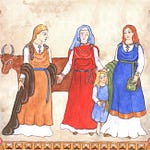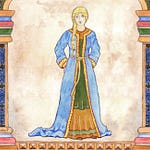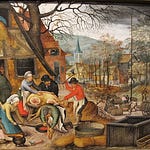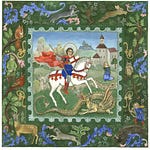Ælfgif-who? provides short biographies of early medieval English women. Click on the podcast player if you’d like to hear this newsletter read aloud in my appealing Yorkshire accent.

Æthelburh of Kent: The Queen who Converted a Kingdom
Long term Ælfgif-who? readers might remember Queen Bertha, a Christian woman who travelled from Francia to Kent in the late sixth century to marry a non-Christian king, Æthelberht. We explored the possibility that it was Bertha’s influence that led to the eventual conversion of the king and the people of Kent to Christianity.
Recently, I was asked to be a guest on History Hit’s Gone Medieval podcast, to discuss another woman whose role in the conversion of an early English kingdom has gone rather unacknowledged: not Bertha, but her daughter, Æthelburh. Æthelburh had a similar story to that of her mother’s - raised a Christian, she married the ‘pagan’ Northumbrian King Edwin, who afterwards converted to his wife’s religion.
According to our main source, the eighth-century Northumbrian monk and historian Bede, Æthelburh’s marriage to Edwin was brokered in around 725 by her brother, Eadbald, after he’d succeeded to his father’s throne. This was not a time when royal women could marry for love - they often functioned as one half of a political alliance between two kingdoms. I don’t think that this necessarily means we should view them as the passive pawns of their male relatives - though what say they had in these alliances may have been minimal. Rather, it might be more accurate to view them as diplomats, being sent to nearby kingdoms to maintain cordial relations between the two, and maintaining the interests of both kingdoms.
In the early seventh century when Æthelburh was born, huge political changes were taking place in the many kingdoms of early medieval England. Large kingdoms were emerging along the east coast of England, two of these being Kent in the south and Northumbria in the north. Despite their distance these kingdoms were linked by the sea. It would have probably taken only two days to travel the 300 mile journey between these kingdoms by boat, an estimate modelled on the ship uncovered in the Sutton Hoo excavation. Such a journey was likely undertaken by Æthelburh as she made her way to her betrothed.
Bede tells us that a condition of Æthelburh’s marriage to Edwin was that he would allow her to practice Christianity and that an Italian monk, Paulinus, would accompany her to Northumbria. Crucially, Edwin agreed that he would be open-minded about converting to Christianity himself. The marital conditions were very similar to those of Æthelburh’s parents, as Bertha also brought a priest with her, Luidhard, who served as the first missionary to Kent.
What Æthelburh’s faith meant to her is something that Bede doesn’t tell us about. He is interested in how kings were converted to the religion of their wives, especially when it involved Roman Christian monks like himself (read about Saint Hild and the Synod of Whitby if you want to understand the difference between Roman and Irish Christianity). But we can extrapolate from the evidence a little here - Æthelburh was obviously a practicing Christian if she needed a churchman to accompany her in order to administer sacred rituals.
Like her mother before her, Æthelburh’s marriage was of great concern to the Pope. Just as Pope Gregory had written to Bertha, Pope Boniface wrote to Æthelburh to express his wish that her husband Edwin would convert to Christianity, using scripture to outline his point. He told her that:
For it is written, 'They two shall be in one flesh.' How can it be said, that there is unity between you, if he continues a stranger to the brightness of your faith, by the interposition of dark and detestable error?
Boniface also quoted Paul’s first letter to the Corinthians 7:14 ‘for the unbelieving husband is sanctified by the believing wife’. The Pope’s message was clear - Edwin must convert in order to protect Æthelburh from being ‘defiled’ by her husband’s idolatry.
Edwin did eventually convert, though according to Bede this was the doing of the missionary Paulinus. In Bede’s story of Edwin’s conversion, the king is persuaded to become Christian when Paulinus reveals a secret symbol to him, that was also shown to him when his life was saved years before in exile. Bede presents this revelation as a matter of personal spiritual realisation, and not, as perhaps was more likely to be the case, a matter of political consideration influenced by many factors - one of which being his wife and queen Æthelburh.
Conversion to Christianity was appealing to non-Christian English kings in this period - it was a prestigious religion that showed continuity with the Roman Empire. Goods from wealthy graves reflect a penchant for mediterranean and Byzantine wares around the time of conversion. Roman Christianity was elite fashion.
More than this though, willingness to convert seems to have been a condition of not only Edwin’s marriage to Æthelburh but also of the political alliance he made with Kent. Converting to another kingdom’s religion might be viewed as a subordinate act. In sending Æthelburh to marry Edwin, her brother may have entrusted in her a diplomatic task to ensure Northumbria’s compliance with Kent.
We can only guess at how Æthelburh may have carried out this task, or indeed followed Pope Boniface’s instructions to personally influence her husband’s decision. At the very least she served as a living example of a pious Christian worshipper within his own household.
Edwin’s conversion meant that his kingdom also converted, which may well have been an oppressive or violent process - but it was not irreversible. When Edwin was killed in battle in 633 the kingdom reverted to the previous religion. While Irish missionaries would continue to convert the Northumbrians, Æthelburh and Paulinus had to flee for their lives back to Kent.
There is some suggestion in a later source called the Kentish Royal Legend that at this point Æthelburh founded and built a mixed-gender monastery at Lyminge. This story has been doubted by some historians, mainly because that would make this the earliest royal monastery ever founded in England.1 A few decades later, it was absolutely the norm that retired queens would found and run their own double monasteries (a few notable examples on Ælfgif-who? being Hild, Eanswith and Æthelthyrth).
Like her mother Bertha, Æthelburh played a role in the conversion of a kingdom that may have been slightly downplayed by Bede, who was looking to really emphasise the role of churchmen. It is only reading between the lines of his narrative that we can acknowledge the roles of these early Christian queens as diplomats, politicians and converters, both within the royal household and beyond.
Paid subscribers can find out more about the role of women in conversion here:
Leaders, Converters, Symbols of Power: Women and the Early English Church
The first half of the seventh century in England is known as the ‘conversion period’, in which the political elites were converted to Christianity through missionary activity. This process of conversion, and the…
Barbara Yorke, Nunneries and the Anglo-Saxon Royal Houses (2003)














Share this post